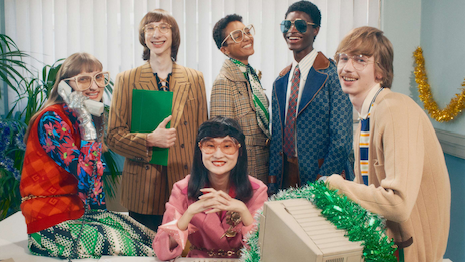 Gucci continues to resonate with luxury consumers due to its ability to evolve its brand. Image credit: Gucci
Gucci continues to resonate with luxury consumers due to its ability to evolve its brand. Image credit: Gucci
Italian fashion label Gucci is Luxury Daily’s 2020 Luxury Marketer of the Year for its adaptability and continued creativity over the course of the COVID-19 pandemic.
Gucci, along with runners-up Burberry and Rolls-Royce, has steadily experimented with different types of content to continuously engage with consumers throughout the pandemic. These three brands have successfully adapted to stay relevant and reach new demographics while maintaining their luxury positioning and prestige during an unprecedented year.
“Gucci has continued to be compelling because of its digital footprint,” said Milton Pedraza, CEO of Luxury Institute, New York. “I think a lot of why Gucci is marketer of the year is the momentum that it built in its digital assets, in its product and creativity, and in its adaptability.
“It has become this super agile behemoth,” he said. “Gucci is also very much in dialogue with its customers, particularly through social media.”
The Luxury Marketer of the Year award was decided based on luxury marketing efforts with impeccable strategy, tactics, creative, executive and results. All candidates selected by the Luxury Daily editorial team and from reader nominations had to have appeared in Luxury Daily coverage this year. Judging was based purely on merit.
Gucci primed for the moment
This year, Gucci found success in by maintaining its recent momentum through a strong digital foundation.
After the gravity of COVID-19 became clear, several fashion labels, including Gucci, pivoted to virtual or livestreamed runway shows and presentations. However, Gucci was among the most inventive and engaging in its digital shift.
Gucci’s Epilogue theme initially began in February when creative director Alessandro Michele brought the dressing rooms to center stage at Milan Fashion Week. Then in July, Mr. Michele presented his Epilogue collection through a live-streaming event accompanied by the release of a visual narrative feature (see story).
The final chapter of the campaign, which was shot by Minnesota-based photographer Alec Soth and filmed by Roman directors Damiano and Fabio D’Innocenzo, was revealed in the fall. Having solidified a relationship with American musician Billie Eilish over the years, Gucci launched the photo campaign in a video released at the singer’s first live-streamed concert event on Oct. 24 (see story).
Gucci’s final Epilogue campaign film
The following month, Gucci showcased another collection while also highlighting the work of emerging designers through a digital film festival. During the weeklong #GucciFest, episodes of Gucci’s Overture of Something That Never Ended, which followed an eccentric character through her day-to-day life in Rome, premiered daily (see story).
Meanwhile, with most Gucci boutiques shuttered, the label revamped its mobile app in March with an emphasis on augmented reality, livestreaming and smartphone shopping (see story).
Gucci later took its augmented reality service to Snapchat to let customers and prospects virtually try on its footwear and buy the merchandise if they choose (see story).
“Gucci is consistent in leveraging its DNA into innovation spaces,” Mr. Pedraza said.
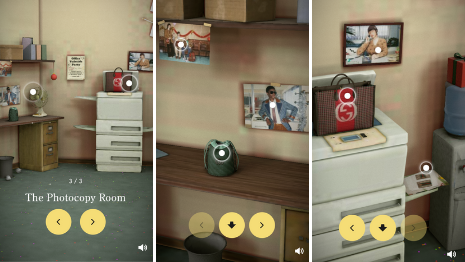 Gucci’s holiday campaign, which was set at an office party, is shoppable on the Gucci App. Image credit: Gucci
Gucci’s holiday campaign, which was set at an office party, is shoppable on the Gucci App. Image credit: Gucci
The fashion label also continues to embrace collaborations with other brands and creatives to reach new consumers.
In February, the brand introduced the #accidentalinfluencer project as a playful take on the notion of imitation and replication for its reissued and reimagined Gucci Tennis 1977 sneaker.
The digital project was interpreted through the lens of London-based artist, photographer and director Max Siedentopf, who also shot the campaign for the Gucci Osteria effort (see story).
In a similar effort, Gucci tasked illustrators, painters and digital artists to create artworks featuring various models of the G-Timeless watch (see story).
Gucci also collaborated with Dazed to launch “Absolute Beginners,” a new series granting various artists their directorial debuts.
Gucci and Dazed challenged a selection of nine artists, from models to actors, to get behind the camera and direct short films for the fashion brand. The artists developed their own screenplays and brought their visions for Gucci to life as directors (see story).
More recently, Gucci released a new nature-inspired campaign showcasing its collaboration with outdoor recreation brand The North Face. Based on the notion that travel leads to self-discovery, the collaboration aims to empower people in their quest to celebrate and express their own characters and personalities (see story).
“[Collaborations] have demonstrated the openness of the brand,” Mr. Pedraza said.
#TheNorthFacexGucci collection will launch globally in early 2021
With the support of parent company Kering, Gucci also continues to make progress on the sustainability front — further endearing itself to younger affluents who are more values-conscious.
In June, the brand debuted Gucci Off The Grid, its first collection from Gucci Circular Lines that is made out of sustainable materials. The apparel and accessories are created using recycled, organic, bio-based and sustainably-sourced materials (see story).
Showing its aptitude with digital media and collaborations, Gucci later partnered with Grimcookies and Harrie, two Sims custom creators, to recreate its Off the Grid capsule collection for the iconic video game (see story).
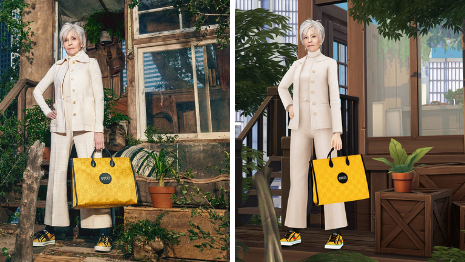 Gucci Off the Grid is now available for Sims. Image credit: Gucci
Gucci Off the Grid is now available for Sims. Image credit: Gucci
The label also worked with resale platform The RealReal to set up an online shop featuring pre-owned Gucci pieces from past collections until the end of 2020 (see story).
This year, Gucci enhanced its Equilibrium digital presence, which serves as a platform for the brand to share its support for social causes and equality issues (see story).
“All the seeds that Gucci planted years ago really blossomed during the pandemic,” Mr. Pedraza said. “And now beyond the pandemic, because the world becomes even more digital in 2021, it will benefit from all of the refinements and the sophistication that it brings to digitalization to sustainability to open creativity to being online and leveraging social media.”
First runner-up: Burberry
British fashion label Burberry has also ramped up its digital offerings in light of the pandemic. While both Gucci and Burberry sustained financial losses during 2020, these efforts have helped the fashion brands remain relevant.
Before widespread lockdowns took effect outside of Asia, Burberry debuted a new augmented reality shopping tool through Google Search technology.
Simulating the in-store experience, the features allows consumers to experience the label’s products embedded in the environment around them, aiding their product discovery and shopping process online and on mobile (see story).
The brand later added a Burberry Virtual feature to its mobile app, encouraging consumers to virtually “try-on” the label’s latest eyewear designs as part of its Summer Monogram efforts (see story).
The Summer Monogram collection promoted through several digital and mobile initiatives. In an online video game called B Surf, players needed to surf through a beachside waterpark and collect B-branded monograms to earn points (see story).
Play B Surf
Introducing our new surf racing game – bringing the world of the TB Summer Monogram collection to life. Use the link to start playing https://t.co/V6inVmSyuF#TBSummerMonogram pic.twitter.com/7cv6KE1eV4
— Burberry (@Burberry) July 8, 2020
Burberry experimented with mobile games
B Surf echoed the themes of the Summer Monogram campaign, which starred Kendall Jenner exploring a dreamlike CGI geometric world inspired by skate-parks and swimming pools, signifying the free spirit and optimism of summer (see story).
In another consumer-facing move, Burberry opened the luxury sector’s first social retail store in Chinese tech hub Shenzhen this July.
The store, backed by Tencent technology in an exclusive partnership, is designed as venue for exploration, inspiration and entertainment, letting shoppers experience Burberry and its products in person and on social media. A dedicated WeChat mini program allows consumers to unlock exclusive content and personalized experiences and share them with their communities (see story).
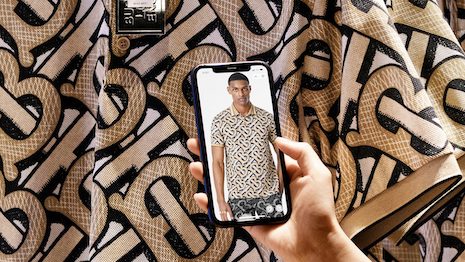 By November 11, over 138,000 visitors experienced Burberry's new social retail store, according to numbers from the brand’s Mini-Program. Image credit: Burberry
By November 11, over 138,000 visitors experienced Burberry's new social retail store, according to numbers from the brand’s Mini-Program. Image credit: Burberry
In the fall, Burberry took its pop-up experiences virtual, engaging luxury shoppers who may not be ready to return to in-person retail.
As part of its Animal Kingdom campaign, online shoppers were able to select which handbag silhouette they are interested in before viewing the different color ways available, including pop-up exclusives. Each physical pop-up was also designed to be carbon neutral through a partnership between Burberry and Wildlife Works, an organization that works to restore threatened animal habitats (see story).
Also in line with its environmental initiatives, the brand introduced sustainability labels to inform customers how a Burberry product meets a range of externally assured stringent criteria. The labeling debuted with the ReBurberry Edit this summer (see story).
“The Burberry DNA has served the brand well this year,” Mr. Pedraza said. “I think it has the same elements of creativity as Gucci.”
Second runner-up: Rolls-Royce
Luxury automakers face different marketing challenges than brands in the apparel sector, particularly this year, but Britain’s Rolls-Royce Motor Cars embraced digital tactics to broaden its appeal to a younger consumer base.
In April, the automaker debuted its “Inspire Greatness” interview series on YouTube. The six episodes featured diverse individuals, including an artist, chef and explorer (see story).
Many of Rolls-Royce’s efforts in 2020 centered on the redesigned Ghost. From an animated series to a new podcast, Rolls-Royce shared details of how the new Ghost has been developed over several years.
The “Ghost Stories” podcast series delved into the five-year process of creating the new Ghost. Johanna Agerman Ross, curator of 20th Century and Contemporary Furniture and Product Design at London’s Victoria & Albert Museum, hosted the five-episode series (see story).
Rolls-Royce shared insights on the development of the new Ghost
Similarly, a four-part animated series shared a behind-the-scenes perspective, through stylized cartoons, of the design and engineering process. Episodes explored the “post-opulence” philosophy, acoustics and other subjects (see story).
Rolls-Royce also celebrated its Wraith Kryptos Collection with a cryptography-inspired mobile game. The interactive game engaged a much wider range of consumers than the owners of the 50 bespoke cars, a unique prizes were available to the first 10 game finalists (see story).
Even prior to the pandemic, Rolls-Royce had begun focusing on digital services designed specifically for its clients.
In February, the automaker formally launched Whispers, its own exclusive members’ club offering unique experiences and access to products and services for owners of a new Rolls-Royce. The offers and content, as well as connections to other likeminded consumers, are available through an app two years in the making (see story).
Rolls-Royce also upgraded its virtual showroom offering for its London flagship as it relocates its boutique and aims to reach more digitally-savvy drivers.
The effort comes as more car buying has shifted to online and digital platforms over the course of the pandemic and subsequent lockdowns, even among the ultra-affluent set. Now, clients will be able to commission bespoke Rolls-Royce vehicles from home (see story).
With an eye to the future, Rolls-Royce rolled out a refreshed branding as the marque looks to modernize its visual identity.
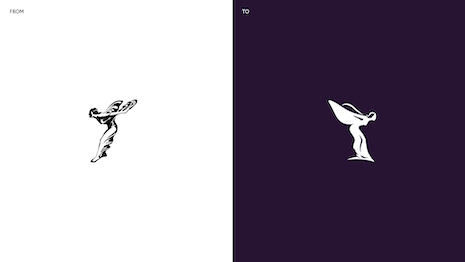 The new illustrated Spirit of Ecstasy will appear on Rolls-Royce digital channels. Image courtesy of Rolls-Royce
The new illustrated Spirit of Ecstasy will appear on Rolls-Royce digital channels. Image courtesy of Rolls-Royce
Rolls-Royce has undergone numerous changes in recent years, including expanding to five models and introducing the edgy Black Badge styling theme. As a result, the marque has welcomed new, younger clients and this rebrand is meant to reflect this evolution (see story).
“Rolls-Royce has really transcended generations and become more of a mindset brand with a cool factor,” Luxury Institute’s Mr. Pedraza said. “And that's hard for a brand like Rolls-Royce to do, but they pulled it off this year.”